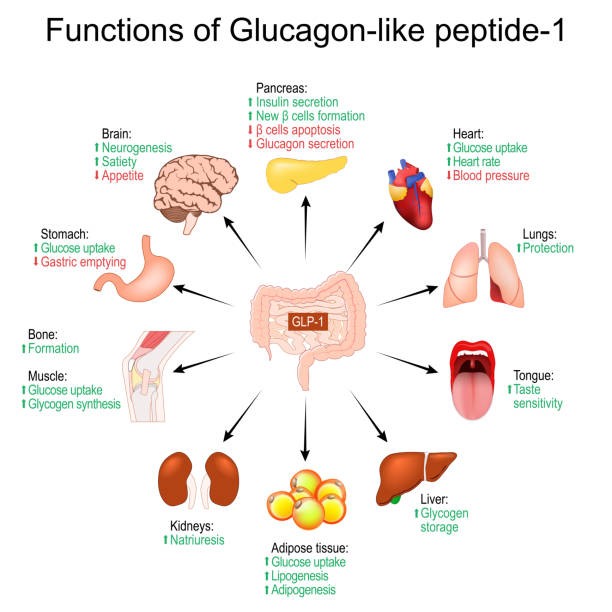If you’re living with type 2 diabetes, then you know how important it is to manage your blood sugar (glucose) levels effectively. GLP-1 receptor agonists might be an option worth considering as they can mimic the effects of a natural hormone in your body called glucagon-like peptide-1 (GLP-1), which has the ability to regulate your appetite as well as your blood glucose levels.
The Role of GLP-1 in Your Body
GLP-1 is part of a group of hormones known as incretins, which are produced in your gut and released after you eat. These hormones work in several ways that are beneficial for you such as:
- They stimulate the release of insulin in response to meals.
- They reduce the secretion of glucagon which is responsible for increasing blood sugar levels.
- They slow down gastric emptying.
- They create a sense of fullness that in turn will decrease your appetite and food intake.

How GLP-1 Receptor Agonists Work
When your doctor prescribes GLP-1 receptor agonists for type 2 diabetes, these medications will replicate or boost the effects of the GLP-1 hormone.
These medications stimulate the production of insulin from your pancreas, but only in response to meals. They reduce your glucagon levels in the body. By lowering the amount of glucagon your body produces, GLP-1 receptor agonists help prevent your blood sugar levels from rising too high. And they also promote slower gastric emptying which means you will feel full longer.
Some GLP-1 agonists might even directly influence the areas of your brain that control hunger, which also means it can aid in appetite suppression and weight management.
What are the Benefits of GLP-1 Receptor Agonists?
One of the standout benefits of GLP-1 receptor agonists is their ability to target post-meal blood sugar spikes specifically. They have a lesser effect on fasting blood sugar levels but can be a powerful tool when combined with other diabetes medications. Because they act mainly in response to food, there’s a lower risk of causing hypoglycemia (low blood sugar) when used alone.
When it comes to long-term effects, GLP-1 receptor agonists can help reduce your A1C levels by 0.5 to 1.2%. The A1C test measures your average blood sugar levels over the past two to three months, giving you and your doctor a good sense of how well your diabetes management plan is working.
Do GLP-1 agonists have other potential benefits?
When it comes to managing type 2 diabetes, GLP-1 receptor agonists offer more than just blood sugar control. These medications come with a host of other potential benefits including:
No Hypoglycemia
One of the significant advantages of GLP-1 receptor agonists is that they don’t cause hypoglycemia (low blood sugar) when used alone. This is a major plus compared to some other diabetes medications.
Possible Weight Loss
On average, users might lose between 1.5 to 3 kilograms when taking GLP-1 receptor agonists medications, although this can vary depending on lifestyle and other medications. GLP-1 receptor agonists have the ability to support weight loss and help maintain a healthy weight. This may be because of several factors.

- GLP-1 receptor agonists can slow down how quickly your stomach empties its contents. This helps you feel full longer.
- These medications interact directly with brain areas responsible for feelings of fullness and satisfaction so you end up eating less and consuming fewer calories.
Heart and Kidney Health Benefits
Research has shown that GLP-1 receptor agonists can have positive effects on heart and kidney health. For individuals with type 2 diabetes and either existing heart disease or risk factors for heart disease, these medications have been found to reduce the likelihood of cardiovascular complications.
Drugs like liraglutide (Victoza), dulaglutide (Trulicity) and semaglutide (Ozempic) have demonstrated these benefits. Moreover, these aforementioned medications may help slow the progression of kidney disease in patients who are at high risk for cardiovascular problems.
Potential Risks and Side Effects of GLP-1 Receptor Agonists
While GLP-1 receptor agonists are generally safe, they can come with some side effects including:
- Vomiting
- Nausea
- Bloating
- Indigestion
- Constipation
- Diarrhea
These gastrointestinal issues are usually mild and short-lived. However, for those with severe gastroesophageal reflux (acid reflux) or gastroparesis (delayed stomach emptying), these medications might exacerbate symptoms. There’s also a small risk of developing pancreatitis (inflammation of the pancreas) with drugs like dulaglutide and liraglutide.
Other potential side effects include:
- Redness, itching, rash, or hives at the injection site.
- Thyroid cancer
Also, since GLP-1 receptor agonists slow digestion, they might affect how your body absorbs other medications so be sure to inform your healthcare provider about all the medications you’re taking.
Short-Acting vs. Long-Acting GLP-1 Receptor Agonists
GLP-1 receptor agonists come in two forms – short-acting and long-acting.
Short-Acting GLP-1 Agonists
- Dosed twice daily
- Greater impact on post-meal blood sugars and slowing gastric emptying
- Lesser effect on fasting glucose levels
Examples of short-acting GLP-1 agonists approved by the FDA include:
- Exenatide (Byetta)
- Liraglutide (Victoza, Saxenda)
- Lixisenatide (Adlyxin)
- Oral semaglutide (Rybelsus)
- Exendin-4
Long-Acting GLP-1 Agonists
- Dosed once daily or once weekly
- More pronounced effect on fasting glucose levels
- Slightly better at reducing A1C results
Examples of long-acting GLP-1 agonists include:
- Exenatide (Bydureon), taken once weekly
- Liraglutide (Victoza), taken once daily
- Dulaglutide (Trulicity), taken once weekly
- Semaglutide (Rybelsus), taken once daily
- Semaglutide (Ozempic), taken once weekly
How to Take GLP-1 Receptor Agonists
Most GLP-1 receptor agonists are administered through subcutaneous injections in the upper arm, stomach or thigh. At the moment, only oral semaglutide is available in pill form. Injectable medications often come in disposable pen devices, which can be either single-use or refillable.
Always follow your healthcare provider’s instructions on how often to take your medication. Short-acting GLP-1 receptor agonists are usually taken once or twice daily, while long-acting versions are often taken once weekly.